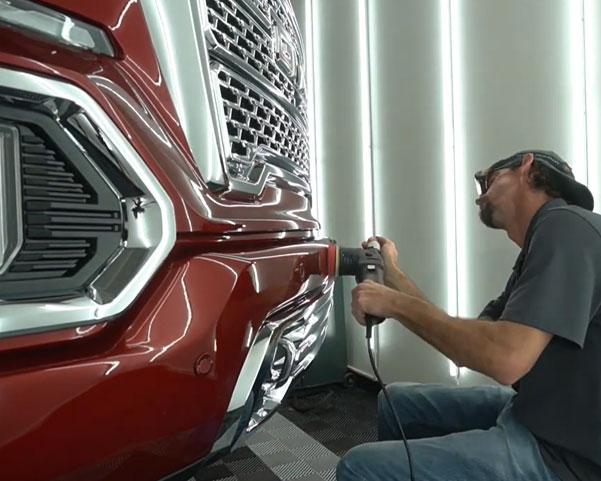Ceramic Coating
What is Ceramic Coatings?
Ceramic coatings are liquid polymers that are applied by hand to the exterior of a vehicle with a microfiber applicator pad. The coating then chemically bonds with the vehicle’s factory paint creating a super hard (9H on the pencil scale, which measures hardness) level of protection.

What Does Ceramic Coating Do?
01
Protects your vehicle's clear coat and paint from UV damage and oxidation.
02
Protects from chemical stains and bird itching
03
Helps with ease of cleaning
Probably one of the most significant features of a ceramic coating is its hydrophobic properties. Which means, its ability to repel water. When a vehicle is coated, water should bead on the surface which should allow the water to slide off more easily. This will allow the harmful contaminants that are carried in rain water such as salt, chlorine, and lead, to have a more difficult time bonding to your vehicle.
04
Gives your vehicle a glossy finish

Ceramic Coatings
Elevating Automotive Protection to Unprecedented Levels

Ceramic coatings represent the pinnacle of automotive surface protection, delivering an unparalleled shield against environmental contaminants, UV rays, and daily wear and tear. These cutting-edge formulations, often based on nanotechnology, create a durable and transparent layer over a vehicle’s paint, providing a range of benefits that redefine the concept of automotive care.
Key Benefits of Ceramic Coatings
Extreme Durability:
Ceramic coatings offer a robust and long-lasting protective layer that bonds chemically with the factory paint, creating a shield that is resistant to scratches, swirls, and chemical contaminants. This durability ensures a sustained glossy finish far beyond traditional waxes and sealants.
Enhanced UV Protection:
The harsh effects of UV rays can lead to paint oxidation and fading over time. Ceramic coatings act as a barrier against UV damage, preserving the vibrancy of the paintwork and preventing premature aging.
Hydrophobic Properties:
One of the standout features of ceramic coatings is their hydrophobic nature. The treated surface becomes highly water-repellent, causing water and contaminants to bead up and roll off effortlessly. This not only facilitates easier cleaning but also reduces the adhesion of contaminants, such as bird droppings and tree sap.
Chemical Resistance:
Ceramic coatings provide a protective barrier against harsh chemicals and environmental contaminants, including acidic rain, bird droppings, bug splatter, and road salts. This chemical resistance helps prevent paint etching and damage, preserving the integrity of the vehicle’s exterior.
Ease of Maintenance:
With the hydrophobic and self-cleaning properties of ceramic coatings, maintaining a pristine appearance becomes significantly easier. Washing and drying the vehicle become quicker processes, and the need for frequent detailing is greatly reduced.

Application Process
The application of ceramic coatings is a meticulous process that requires expertise to ensure optimal performance. The general steps include:
Surface Preparation:
Thoroughly wash and decontaminate the vehicle’s surface to remove dirt, grime, and contaminants. This may involve claying, polishing, and other preparatory steps to achieve a clean and smooth surface.
Application of Ceramic Coating:
The coating is applied in a controlled environment, ensuring proper curing and bonding. Technicians meticulously coat each panel, allowing the formulation to bond chemically with the factory paint.
Curing and Bonding:
The coated vehicle is left to cure, allowing the ceramic coating to form a durable bond with the paint. This process may involve infrared curing or natural drying, depending on the specific product used.
Quality Inspection:
After curing, the vehicle undergoes a comprehensive quality inspection to ensure uniform coverage and a flawless finish.
Longevity
Ceramic coatings are renowned for their long-lasting protection, with durability typically ranging from one to several years, depending on the product used and environmental conditions. Routine maintenance, such as gentle handwashing and avoiding abrasive cleaning methods, can contribute to extending the coating’s longevity. Periodic inspections and maintenance applications may be recommended to maximize the protective benefits over time.
In summary, ceramic coatings redefine automotive protection by offering durability, enhanced aesthetics, and simplified maintenance. The meticulous application process, combined with their longevity, makes ceramic coatings a premium choice for enthusiasts seeking the utmost in vehicle care and preservation.
